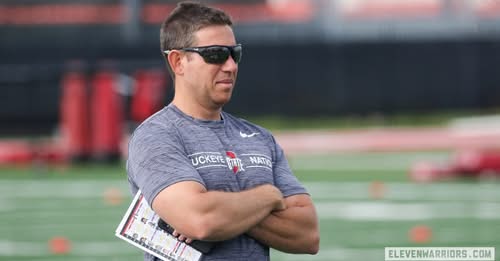ChatGPT said:
Mark Pantoni’s name might not resonate with the casual college football fan in the same way that a head coach or a star quarterback does, but within the ecosystem of the sport, particularly inside the walls of the Woody Hayes Athletic Center, his name carries monumental weight. As Ohio State’s general manager and the architect behind their relentless recruiting machine, Pantoni has not only elevated the Buckeyes to perennial national title contenders but also revolutionized the operational model of elite-level college football programs. It’s no stretch, then, to state that in the world of college football’s off-field strategists, Mark Pantoni is the Executive of the Year.
While many universities are just now embracing the role of a “general manager” within their football programs, Ohio State has long benefitted from Pantoni’s early adoption of this administrative, analytical, and talent-centric role. He arrived in Columbus in 2012 with Urban Meyer, having previously served as Meyer’s right-hand man at Florida, and has since stayed on under Ryan Day. Over that span, he has not only adapted to the changing landscape of college football but has often been steps ahead of it. His role isn’t merely administrative. Pantoni is deeply involved in player evaluation, roster management, transfer portal assessments, NIL alignment, and the cohesion between high school recruiting and the internal culture of the team. Essentially, he is the connective tissue binding Ohio State’s on-field success to its off-field strategy.
The 2025 recruiting cycle, a key example of his brilliance, showcased just how vital Pantoni is. Ohio State secured commitments from several five-star prospects, many of whom had national offers from powerhouse programs like Georgia, Alabama, USC, and Texas. This isn’t merely the result of a shiny logo or tradition—it’s strategic warfare. Pantoni runs a recruiting operation with the discipline and precision of a military unit. From meticulously organized campus visits, to deeply personalized relationships with recruits and their families, to building up a dynamic digital media presentation that appeals to a generation raised on social media and instant brand access, Pantoni has overseen every piece of the puzzle. But unlike some general managers who stay in the shadows, his fingerprints are everywhere. When a top recruit commits to Ohio State and mentions “the family feel” or “how organized everything was,” they’re often describing the environment Pantoni built.
Beyond recruiting, Pantoni’s operational foresight is unmatched. As the NCAA’s rules evolved, and the transfer portal became a defining element of modern roster building, Pantoni didn’t just adapt—he thrived. Ohio State under his guidance has avoided some of the portal chaos that has engulfed other top-tier programs. While teams across the country have scrambled to retain talent or find last-minute fixes, Pantoni’s approach has remained proactive. His internal evaluations and personnel grading systems allow the Buckeyes to know exactly where depth is lacking and where veteran talent can complement incoming freshmen. This means Ohio State isn’t just building elite rosters; they’re building them with a sense of balance and longevity.
Furthermore, as NIL (Name, Image, and Likeness) has shifted the recruiting landscape, Pantoni has once again been at the forefront of adaptation. While Ohio State doesn’t publicly advertise NIL promises like some programs have been accused of doing, the infrastructure Pantoni supports ensures recruits and current players are well-informed and positioned to succeed. He’s played an integral role in aligning Ohio State’s collectives and business partnerships in a way that appeals to athletes but also preserves the integrity of the program’s culture. Maintaining this balance—offering competitiveness in the NIL space without devolving into a bidding war model—takes strategic discipline, and Pantoni has helped Day and the university walk that tightrope with remarkable steadiness.
One of the more understated aspects of Pantoni’s excellence is his understanding of culture. At a program like Ohio State, talent alone doesn’t ensure success. Players must fit into a culture of toughness, accountability, and unrelenting competitiveness. Pantoni’s evaluation model isn’t limited to speed, size, or rankings. He emphasizes character, team mentality, and psychological makeup. It’s why so many Ohio State stars are not just physical standouts but leaders—players like C.J. Stroud, Marvin Harrison Jr., J.T. Tuimoloau, and Emeka Egbuka, all of whom were considered not just elite athletes but exemplary young men. Pantoni’s emphasis on this type of player has helped Ohio State avoid many of the locker room dysfunctions that have plagued other blueblood programs.
Perhaps what is most impressive about Pantoni’s contributions is that he operates largely without public fanfare. While coaches make millions and receive the spotlight, Pantoni’s influence is quieter, more deliberate, and arguably just as essential. There are recruiting insiders across the country who will quietly admit that there is no one better in college football than Pantoni at running a comprehensive, innovative, and ethical recruiting and personnel operation. His work ethic is legendary. Recruits and their families often describe his tireless availability, how he communicates at all hours, and how he remembers small details from conversations that make interactions feel meaningful and genuine. In an age where relationships matter more than ever in recruiting, Pantoni’s human touch is part of what keeps Ohio State at the top.
When you compare Ohio State’s operational efficiency under Pantoni to other major programs, the gap becomes apparent. While some schools spend their energy putting out fires caused by over-promising NIL deals or locker room instability, Pantoni’s systems insulate the Buckeyes from such chaos. This stability allows coaches to focus more on development and game planning rather than personnel drama. Pantoni’s comprehensive planning ensures that by the time fall camp arrives, the roster is not just talented—it’s organized, cohesive, and aligned with the staff’s vision.
Moreover, Pantoni’s reputation has now reached the point where even assistant coaches who consider joining Ohio State often cite his leadership and organization as reasons to take the job. Coaches want to work in systems where they aren’t chasing down transcripts or dealing with logistical chaos during official visits. Pantoni provides that streamlined foundation. His staff is highly trained, with delegated roles that ensure everything from housing, academic fit, and family hospitality is handled with professionalism. Recruits often feel they are being courted by an NFL-level operation, and that’s no accident.
What makes his 2025 campaign so award-worthy is the fact that he managed all of this amid unprecedented turbulence in the college football world. Between conference realignment, NIL legal battles, and ongoing changes to the College Football Playoff structure, many programs have seen instability. Pantoni turned chaos into consistency. The Buckeyes not only retained their core staff amid poaching attempts, but they also secured elite talent in key positions, addressed depth issues through the portal, and ensured their NIL narrative remained clean and competitive.
Pantoni’s recognition as college football’s Executive of the Year is not just about one recruiting class or one savvy transfer portal haul. It’s about sustained excellence in a constantly shifting landscape. His success is a blueprint for modern college football programs trying to maintain both tradition and relevance. Every major football power in the country is now racing to replicate Ohio State’s internal structure, but Pantoni’s consistency, humility, and cutting-edge mindset make duplication difficult.
There’s a reason why Urban Meyer once said that Pantoni was the “most important hire he made” at both Florida and Ohio State. There’s a reason why Ryan Day has gone to great lengths to retain him, even as NFL teams and other major college programs have inquired about his availability. And there’s a reason why every high school coach in the Midwest, and many across the country, know and respect his name. Mark Pantoni is the pulse behind the scenes, the strategist in the shadows, and the man responsible for the sustained excellence of Ohio State football. He has taken the raw ingredients of talent, culture, and discipline, and turned them into a product that competes for championships year after year.
In today’s college football, where chaos reigns and the rules seem to change with every legislative session, having someone like Pantoni steering the off-field operations is like having a world-class captain navigating treacherous waters. Programs are learning that facilities, budgets, and brands can only take you so far. The difference between good and great often lies in the margins, in the unseen hours of organization, evaluation, and execution. And in those margins, no one in the nation operates with more precision than Mark Pantoni.
So while the Heisman Trophy is reserved for quarterbacks and receivers, and the Coach of the Year award goes to the man pacing the sidelines, it’s time to recognize that modern college football has another indispensable figure—the executive. And for 2025, no executive has done more to elevate a program, maintain its elite standard, and navigate the complexities of a new era than Ohio State’s Mark Pantoni. The title of College Football’s Executive of the Year fits him not just because of his results, but because he helped define what that title should even mean.



